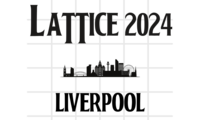Speaker
Description
In the PACS10 project, the PACS collaboration have generated three sets of the PACS10 gauge configurations at the physical point with lattice volume larger than $(\mbox{10 fm})^4$ and three different lattice spacings. The isovector nucleon form factors had been already calculated by using two sets of the PACS10 gauge configurations. In our strategy, the smearing parameters of the nucleon interpolation operator were highly optimized to eliminate as much as possible the contribution of excited states in the nucleon two-point function. This strategy was quite successful in calculations of the electric ($G_E$), magnetic ($G_M$) and axial-vector ($F_A$) form factors, while the induced pseudoscalar $(F_P)$ and pseudoscalar ($G_P$) form factors remained strongly affected by residual contamination of $\pi N$-state contribution. In this talk, we propose a simple method to remove the $\pi N$-state contamination from the $F_P$ form factor, and then evaluate the induced pseudoscalar charge $g_P^*$ and the pion-nucleon coupling $g_{\pi NN}$ from existing data in a new analysis. Applying this method to the $G_P$ form factor will also be considered.

